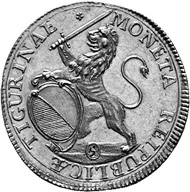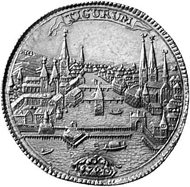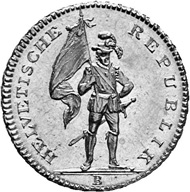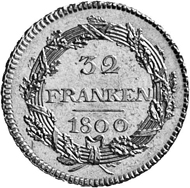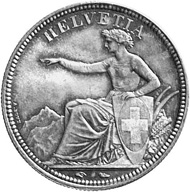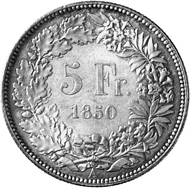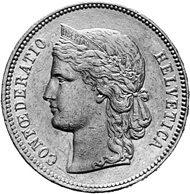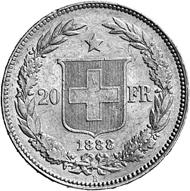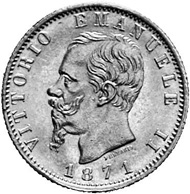Our occasional series ‘The People of Zurich and their Money’ will present one exciting chapter of Swiss numismatics and economic history at a time. The introduction provides an initial overview in two parts. This second section takes us from the Thirty Years War all the way to the present day.
Zurich. 5 ducats 1720. Lion with sword and coat of arms cartouche walking towards the left. Rev. Zurich cityscape as seen from the water.
Europe Courts Zurich
The people of Zurich had the great fortune of being able to stay out of the Thirty Years War and, so, were spared its devastation. This fortunate position also allowed them to undergo a rebuilding boom earlier than neighbouring lands. By the last quarter of the 17th century, at latest, Zurich was taking in more money in taxes than it could ever manage to spend. Ten thousand gulden poured into the state treasury every year, quite a substantial sum at the time. Even more staggering is the fact that between 1672 and 1798, at a time when most other territorial rulers in Europe were on the verge of or even declaring bankruptcy, Zurich managed to generate a net profit of just over three million gulden.
Zurich’s enviable financial climate made it a much-courted city, and many a prince looked to it in the hopes of receiving some sort of aid for their ruined finances. From the Duke of Wurtemberg to the Prince of Schwarzenberg, and even the German Emperor – all hoped to tap into the people of Zurich’s resources. Most politely declined, however, citing the excuse that as confederates, they had an obligation to remain impartial.
Zurich. Double doubloon of 32 francs, 1800, minted in Bern. From the front, a warrior, the flag of the Republic in his hand. Rev. 32 / FRANCS / 1800 in an oak wreath.
The Revolution Grazes Zurich
Between the increasingly absolutist presence of the Council, the yawning divides between the economic well being of the urban vs. the rural population and, lastly, antiquated moral codes of conduct, there was enormous discontent with the old regime; so much so, in fact, that a large segment of the population welcomed the soldiers of the French Republic with open arms.
On March 29, 1798, Zurich was forced to align itself with the Helvetic Republic and consequently, to adopt the constitution imposed by France. With this, the French assumed control not just over Zurich’s state treasury, but also over the task of the internal monetary system. The initial idea was to create a currency for the entire Helvetic Republic, but this attempt failed. Financial difficulties hampered efforts to mint enough coins of the new currency to supply to the entire Republic, and so the old coins continued to circulate. The experiment with a uniform currency failed as early as 1803, along with the entire Helvetic Republic. This was the year that Napoleon passed the Act of Mediation, which restored the old cantonal system and re-established the cantons as autonomous political entities with their own minting rights.
A Bank in Zurich. 10 Brabant thalers, issued on 27.5.1837.
Progress and Restoration
In 1805, Hans Caspar Escher established his mechanical spinning factory, marking the onset of industrialization in the canton of Zurich, with all its assets and drawbacks. From a political perspective, the first half of the 19th century was significant in that the 1831 constitution finally recognized the equality of the inhabitants of both the canton and the city. Moreover, Zurich’s progressive education policy and liberal economic policy made it a sort of centre of industrializing Switzerland.
Large-scale projects like the first Swiss train line between Zurich and Baden, for example, could no longer be financed just through individuals or a few businessmen – there was now a growing need for additional means of raising capital. This need led to the first heyday of the public holdings company.
In order to cover the expenses incurred by these large-scale projects, a new form of money with a higher face value was also needed. In 1837, the first Zurich banknotes were issued.
Swiss Confederacy. 5 francs 1850, minted in Paris. Helvetia with the Swiss coat of arms sits before an Alpine landscape. Rev. 5 Fr / 1850 in a wreath of oak leaves and Alpine flowers.
The Birth of the Swiss Franc
The creation of a unified currency for the entire Swiss Confederacy had already been stipulated in an 1832 draft of the constitution, but at first there was no agreement as to what exactly this currency should be. The western cantons were considering the French monetary system, with its easy to manage and straightforward decimal structure, while the German-speaking cantons leant more towards the guldens of the South German monetary system.
A decision was made on May 7, when the Federal Assembly, charged in the 1848 constitution with the task of creating the new currency, ultimately opted for the French monetary system. A federal law specified the coins to be minted, whereby it was clear from the outset that Switzerland would still temporarily have to rely on the circulation of foreign money. Since Switzerland didn’t have the capacity to mint such large quantities of money so quickly, the first Swiss francs were produced in Paris and Strasbourg.
Between the summer of 1851 and the summer of 1852, all old coins in the country were exchanged for new ones, and all debts and title deeds were converted into the new currency.
Swiss Confederacy. 20 francs 1888, minted in Bern. Female head facing left. Rev. Swiss coat of arms in a wreath of laurel and oak branches.
The Latin Monetary Union
Right from the introduction of the Swiss Franc, those in charge were fully aware that Switzerland was not in a position to provide sufficient coinage to satisfy the country’s cash needs.
To remedy this, a law was enacted in 1850 that also made silver coins from France, Belgium, Sardinia, Parma, the Cisalpine Republic (a republic established by Napoleon in 1797 whose capital was Milan) and the Kingdom of Italy legal forms of payment.
Italy. 20 lira 1871. Head of Vittorio Emanuele II. Rev. Crowned escutcheon between laurel wreaths.
These aforementioned countries were all founding members of the Latin Monetary Union. This accord, which effectively pre-empted the Euro by a good 100 years, permitted the free circulation of member countries’ coins within their own national territories. This important treaty was concluded on France’s initiative on December 23, 1865 and later ratified by Switzerland on March 5, 1866.
The Franc Becomes Switzerland’s Sole Currency
The immense costs incurred during the First World War spelled the end of the Latin Monetary Union, despite the fact that it still existed on paper until 1926. Member countries were forced to reduce the silver content of their stampings so drastically that it no longer complied with union agreements. Paper money took the place of coins, and Switzerland found itself faced with the task of minting sufficient money for its own citizens in order to keep the ‘inadequate’ stampings of the treaty partners away from their country.
Belgium was the first land to leave the treaty in 1926, and in 1927, Switzerland enacted a law stipulating for the first time that Switzerland could only permit the circulation of its own coins.
Streamlining in the Name of Progress
Although international collaboration had proven unsuccessful with respect to monetary matters, the Swiss were thriving on a national basis, as was Zurich’s economy. New management methods became more prevalent. Modern managers estimated costs using objective cost-benefit analyses, and streamlining helped reduce production, storage and transport costs, and therefore increased profits. Advertising opened up new sales markets and prices were reduced for certain products. Ultimately, the profits yielded by the new management methods proved beneficial not just for businesses, but also for consumers.
The Limits to Growth
The economic crisis that originated in the United States in 1929 was slow to reach Switzerland, but eventually did in 1931. Due to the de-coupling of the English pound and the American dollar from the gold standard and the subsequent devaluation of both currencies, the exchange rate of the Swiss franc climbed so much that it made export virtually impossible. This led to mass layoffs, and in 1936, at the peak of the crisis, more than 20,000 people in the canton of Zurich were registered as seeking employment. For those who were still employed, life continued more or less as usual, but poverty loomed for the many families whose breadwinners now found themselves out of work.
When the French government informed the Swiss President of the Federal Council in September that France too was facing a devaluation of their currency, Switzerland also decided to de-couple the franc from the gold standard. The next year, unemployment in the canton of Zurich had already dropped by about a fifth.
The sculpture group Drei Gnomen (The Three Gnomes) was created by the artist Imre Mesterhàzy from Zurich. © MoneyMuseum.
A Stable Currency Without an Anchor
In 1936, the gold parity of the Swiss franc was newly determined at a range between 0.190 and 0.215 g, not least because the franc had proved to be a safe haven currency during the Second World War. Zurich’s rise into an internationally in demand banking centre came about a bit later. The banks were able to act as intermediaries between the Swiss companies that needed capital for their expanding operations and the small-scale savers, who entrusted the banks with the management of their assets.
Zurich garnered international attention as a banking centre due to the stability of the Swiss franc and their guaranteed banking confidentiality. Its ascendancy happened so unremarkably and quietly, however, that the British Foreign Secretary, George Brown, in anger over the weakness of the British pound in 1964, referred to the ‘gnomes of Zurich.’ He was comparing the clandestine, underground workings of the legendary earth and mountain spirits with those of Zurich’s humble bank employees.
International trust in the Swiss Franc continued to remain stable, even when a sudden rise in the price of silver in 1968 compelled the Swiss government to abandon all relationships of Swiss currency to precious metal. Zurich continued to flourish as a financial centre.
What’s the Situation Like Today?
Today’s events will be tomorrow’s history.
As we’re all such children of our time, it’s quite difficult to try to gauge its historical significance. Only our descendants will really be able to interpret the history of our current age.
But what exactly will they have to say about our era? Perhaps that it was fairly insignificant when you take into account humanity’s long evolution? That important decisions were made regarding the advancement of money? Will they look at our age as the age in which virtual money supplanted cash? Will they regard it as the big crash that did away with all traditional forms of money? Or will they maybe even fete us as the ones who set the definitive course for new alternative forms of money?
Only the future will ultimately determine what role our age will play in the grand scheme of history. But one thing’s for certain – a future completely devoid of money is no longer conceivable.
Check out the next section to see how it all began in Zurich: with the Celts and Greek money …
You can find all parts of the series ‘The People of Zurich and their Money’ here.




